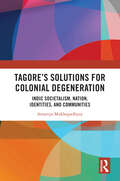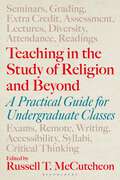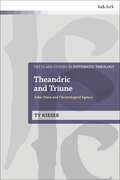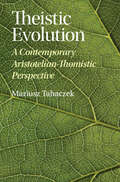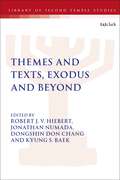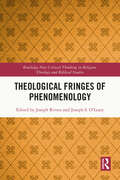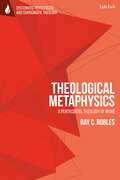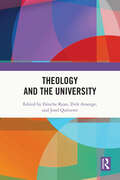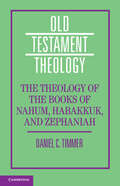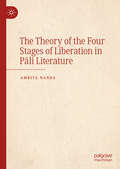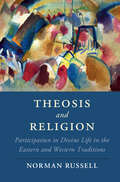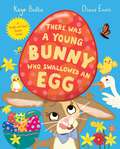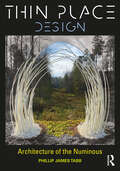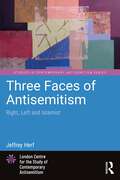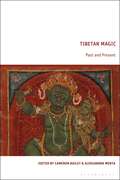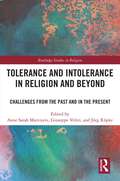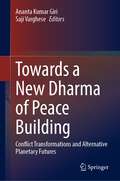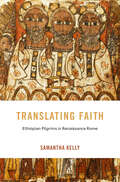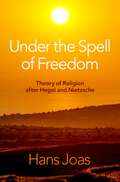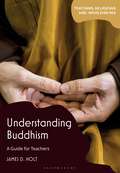- Table View
- List View
Tagore’s Solutions for Colonial Degeneration: Indic Societalism, Nation, Identities, and Communities
by Amartya MukhopadhyayThis book focuses on Rabindranath Tagore as a social and political thinker revolving around Tagore’s ideas on the seeds of civil society, nation, identities, and communities in the Indic tradition. The author deconstructs Tagore’s concepts against the appropriate resurgent and triumphalist Western concepts in the updated Western social thought and theories. The book examines Tagore’s understanding of the nature of the civil social sphere in India and analyzes the relevance of his civil social concepts against the backdrop of colonialism in India. It also discusses his views on nation and nationalism in India and his insights into the problems and prospects of intercommunity, particularly Hindu-Muslim relations in India. Applying current social science and Western literature in an unprecedented manner to interpret Tagore, this book will be of great interest to scholars, teachers, and students of politics, nationalism, postcolonialism, history, comparative literature, sociology, religious studies, and South Asian studies.
Teaching in the Study of Religion and Beyond: A Practical Guide for Undergraduate Classes
by Russell T. McCutcheonDrawing on their wide experience in the undergraduate classroom, the contributors address basic but current issues in university teaching. This book provides practical commentary and invites instructors to consider how to address the learning needs of their students, while taking into account the wider structural requirements of administrations, governments, or credentialing agencies.Consisting of about forty, readable, short entries – on topics ranging from curriculum, grading, group work, digital humanities and large lectures, to learning management systems, office hours, online/remote courses, recruiting and seminars – this book provides a wealth of practical help and reassurance to teachers working with undergraduate students.This book is a valuable tool for early instructors in universities and colleges, showing them how to impact a class's success. It provides a critical background on the issues involved whilst also offering suggestions on how to navigate the competing demands on teachers.
Theandric and Triune: John Owen and Christological Agency (T&T Clark Studies in Systematic Theology)
by Ty KieserDescribing Jesus as an “agent” of divine actions, or as one who possesses human “agency,” is commonplace in christological discussions. Yet these discussions often wade in a shallow understanding of the terms' meanings and the theological implications of such claims. For example, while many theologians who are committed to the definition of Chalcedon consider Jesus one agent, we might ask if this implies that the triune God comprises “three agents?” Or, if Christ possesses “singular agency,” how are his divinity and humanity operative in his actions?In response, this work draws from the theology of John Owen and advancements in philosophy of action in order to offer an account of divine and human agency in christological action from within the Reformed tradition. It provides clarity to the christological and trinitarian uses of the language of “agent/agency” in Christ and attends to the theological (esp. trinitarian) entailments therein. While at first glance there may appear to be internal inconsistencies with accounts that subscribe to classical trinitarianism and Reformed Christological agency, this book argues that Owen helps us recover an understanding of christological agency that is internally coherent and theologically prudent. As such the Reformed tradition can articulate Christological “agency” in a way that is coherent with the testimony of Scripture, the ecumenical councils, and classical trinitarianism while contributing to contemporary theological discussions. The case not only provides terminological clarity and theological coherence, but also inclines Christians to appreciate the trinitarian love of God in Christ's action and the human sympathy of Christ for his people.
Themes and Texts, Exodus and Beyond (The Library of Second Temple Studies)
by Robert J. V. Hiebert, Jonathan Numada, Don Dongshin Chang, Kyung S. BaekThis volume of essays is focused on the significance of the book of Exodus for studies in the Septuagint, Second Temple Jewish literature, the New Testament, and Christian theology. A diverse group of scholars from various parts of the world, many of whom are well-known in their fields, employs a range of methodologies in the treatment of text-critical, linguistic, literary, historical, cultural, exegetical, intertextual, and theological topics. Parts of the relevant literary corpus that are dealt with in relation to the book of Exodus include Genesis, Leviticus, Deuteronomy, Psalms, Zechariah, 3 Maccabees, the Gospels of Matthew and Mark, the Epistles of 1 Thessalonians, Hebrews, and 1 Peter, as well as the Dead Sea Scrolls. This book will be a valuable resource for scholars and students in the areas of biblical and theological studies, as well as clergy.The distinguished contributors include Emanuel Tov, Albert Pietersma, Daniela Scialabba, Craig A. Evans, James M. Scott, Martin G. Abegg Jr., and Wolfgang Kraus.
Theological Fringes of Phenomenology (Routledge New Critical Thinking in Religion, Theology and Biblical Studies)
This book focuses on the relationships between phenomenology and theology, which have been varied and complex but seem currently in an inconclusive and loosely defined state. Methodological rigor is not much in evidence, and the two disciplines continue to defy any authoritative synthesis. While both disciplines grapple with questions concerning the fundamental structures of human experience, their relationship is troubled by the elusive roles of Revelation and faith, which threaten the scientific autonomy of philosophy on one side and disable theologians for consistent philosophical discourse on the other. This volume revisits that conundrum from various perspectives, as it at once repristinates some of the most vibrant points of encounter and opens possibilities for new beginnings. It begins with the theological musings into which leading phenomenologists have been drawn from the start, with special reference to Husserl, Heidegger, and Michel Henry, as well as backward glances to Fichte, Schelling, and Blondel. A second section takes up specific theological themes and examines how phenomenological approaches can refine thinking on them. These include the Incarnation, the Resurrection, the Eucharist, Grace, and Prayer. A dialogue between phenomenology and classical theologians is staged in the third section: Augustine, Pseudo-Dionysius, Eckhart, and Karl Rahner. The closing section ranges more widely, discussing atheism, non-realist theology, and Hinduism from phenomenological angles, and showing how these topics too come within the ambit of theology.
Theological Fringes of Phenomenology (Routledge New Critical Thinking in Religion, Theology and Biblical Studies)
by Joseph Rivera Joseph S. O’LearyThis book focuses on the relationships between phenomenology and theology, which have been varied and complex but seem currently in an inconclusive and loosely defined state. Methodological rigor is not much in evidence, and the two disciplines continue to defy any authoritative synthesis. While both disciplines grapple with questions concerning the fundamental structures of human experience, their relationship is troubled by the elusive roles of Revelation and faith, which threaten the scientific autonomy of philosophy on one side and disable theologians for consistent philosophical discourse on the other. This volume revisits that conundrum from various perspectives, as it at once repristinates some of the most vibrant points of encounter and opens possibilities for new beginnings. It begins with the theological musings into which leading phenomenologists have been drawn from the start, with special reference to Husserl, Heidegger, and Michel Henry, as well as backward glances to Fichte, Schelling, and Blondel. A second section takes up specific theological themes and examines how phenomenological approaches can refine thinking on them. These include the Incarnation, the Resurrection, the Eucharist, Grace, and Prayer. A dialogue between phenomenology and classical theologians is staged in the third section: Augustine, Pseudo-Dionysius, Eckhart, and Karl Rahner. The closing section ranges more widely, discussing atheism, non-realist theology, and Hinduism from phenomenological angles, and showing how these topics too come within the ambit of theology.
Theological Metaphysics: A Pentecostal Theology of Being (T&T Clark Systematic Pentecostal and Charismatic Theology)
by Dr Ray C. RoblesInsofar as Christian theology aims to make truthful claims about the nature of reality, it is necessarily involved in the enterprise of metaphysics. Pentecostals, precisely as Christians, are thus obliged to participate. Through this study it becomes evident that pentecostals aim to participate in the metaphysical discipline in the same way they theologize - that is, informed by the norms, practices, and speech acts that constitute their spirituality. This book aims to construct a Christian metaphysics that is at once attuned to pentecostal spirituality/theology and informed by the classical tradition of Christian metaphysics. Ultimately, this work offers a constructive and critical engagement with pentecostal spirituality, and with pentecostal theology via the larger ecumenical, creedal, and dogmatic metaphysical tradition. Thus, this book is explicitly and intentionally limited to understand metaphysics in conversation with the historical Christian tradition, and to understand a pentecostal vision of it.
Theology and the University
by Fáinche Ryan Dirk Ansorge Josef QuittererTheology and the University presents a compelling argument as to why theology still matters. It considers how theology has been marginalised in the academy and in public life, arguing that doing so has serious repercussions for the integrity of the academic study of religion.The chapters in this book demonstrate how theology, as the only discipline which represents religion from within, provides insight into aspects of religion which are hidden from the social sciences. Against a backdrop of heated debates on the role of the humanities in the university, the book highlights the specific contribution of theological education and research to the work of a university, providing essential information for academic and social/political decision-making. Whilst the book has an emphasis on the Catholic tradition, it explores the prospect of fruitful complementarity and interdisciplinarity both with secularised studies of religion, and other disciplines in the university, such as literature, philosophy, and the social sciences.This book provides orientation for decision-makers, particularly those concerned with the broader question of humanities in the university; students in their choice of study; those interested in the wellbeing of today’s universities; and ecclesial authorities seeking to form leaders capable of intelligent responses to the issues of contemporary society. It is a must read for all researchers of theology, as well as anyone interested in the role of the humanities more broadly.
Theology and the University
Theology and the University presents a compelling argument as to why theology still matters. It considers how theology has been marginalised in the academy and in public life, arguing that doing so has serious repercussions for the integrity of the academic study of religion.The chapters in this book demonstrate how theology, as the only discipline which represents religion from within, provides insight into aspects of religion which are hidden from the social sciences. Against a backdrop of heated debates on the role of the humanities in the university, the book highlights the specific contribution of theological education and research to the work of a university, providing essential information for academic and social/political decision-making. Whilst the book has an emphasis on the Catholic tradition, it explores the prospect of fruitful complementarity and interdisciplinarity both with secularised studies of religion, and other disciplines in the university, such as literature, philosophy, and the social sciences.This book provides orientation for decision-makers, particularly those concerned with the broader question of humanities in the university; students in their choice of study; those interested in the wellbeing of today’s universities; and ecclesial authorities seeking to form leaders capable of intelligent responses to the issues of contemporary society. It is a must read for all researchers of theology, as well as anyone interested in the role of the humanities more broadly.
The Theology of the Books of Nahum, Habakkuk, and Zephaniah (Old Testament Theology)
by null Daniel C. TimmerThe books of Nahum, Habakkuk, and Zephaniah address problems in and around ancient Judah in ways that are as incisive and critical as they are optimistic and constructive. Daniel C. Timmer's The Theology of the Books of Nahum, Habakkuk, and Zephaniah situates these books in their social and political contexts, examining the unique theology of each as it engages thorny problems in Judah and beyond. In dialogue with recent scholarship, this study focuses on these books' analysis and evaluation of the world as it is, focusing on both human beings and their actions, and God's commitment to purify, restore, and perfect the world. Timmer also surveys these books' later theological use and cultural reception. His study brings their theology into dialogue with concerns as varied as ecology, nationalism, and widespread injustice. It highlights the enduring significance of divine justice and grace for solid hope and effective service in our world.
The Theory of the Four Stages of Liberation in Pāli Literature
by Amrita NandaThis book investigates the origins and development of the theory of four stages of liberation in Pāli literature. This theory is an important soteriological cartography in early Buddhism, particularly Theravāda Buddhism. Amrita Nanda challenges the traditional interpretation of the four stages by recognizing the impact of the changing socio-religious factors on the theory’s origins and subsequent development. Based primarily on the Pali literary sources, this study utilizes sometimes-overlooked aspects of these texts. This book first traces the origins of each stage individually; then, it traces the formation of the theory and its subsequent development.
Theosis and Religion: Participation in Divine Life in the Eastern and Western Traditions (Cambridge Studies in Religion, Philosophy, and Society)
by null Norman RussellTheosis, originally a Greek term for Christian divinisation or deification, has become a vogue word in modern theology. Although recent publications have explored its meaning in a selection of different contexts, this is the first book to offer a coherent narrative of how the concept of theosis developed in both its Eastern and Western versions. Norman Russell shows how the role of Dionysius the Areopagite was pivotal, not only in Byzantium but also in the late mediaeval West, where it strengthened the turn towards an individualistic interiority. Russell also relates theosis to changing concepts of religion in the modern age. He investigates the Russian version of theosis, introduced in the West by Russian members the Paris School after the 1917 Revolution. Since then, theosis has undergone additional development through the addition of esoteric elements which have since passed into the mainstream of all theological traditions and even into popular spirituality.
There Was a Young Bunny Who Swallowed an Egg: A laugh out loud Easter treat!
by Kaye BaillieA laugh-out-loud Easter eggstravaganza, There Was a Young Bunny who Swallowed an Egg from Kaye Baillie and award-winning illustrator Diane Ewen is the perfect springtime story for little ones!Everyone's heard about the old lady who swallowed a fly, but now it’s time to meet a little bunny who, just as the Easter Egg Hunt is starting, swallows . . . an egg! And she doesn't stop there! Soon she's gobbled down a chick, a hot-cross bun, and a basket! What will she gobble down next?A funny, cumulative rhyming story young children will love, packed with Easter chicks, eggs, buns, bees, and one very hungry little bunny – keep an eye on your chocolate eggs!
Thin Place Design: Architecture of the Numinous
by Phillip James TabbWhat makes the places we inhabit extraordinary? Why are some urban spaces more vital and restorative? Wonderful landscapes, inspiring works of architecture and urban design, and the numinous experiences that accompany them have been an integral dimension of our culture. Up-lifting spaces, dramatic use of natural light, harmonic proportional geometry, magical landscapes, historic sites and vital city centers create special, even sacred moments in architecture and planning. This quality of experience is often seen as an aesthetic purpose intended to inspire, ennoble, ensoul and spiritually renew. Architecture and urban spaces, functioning in this way, are considered to be thin places.
Thin Place Design: Architecture of the Numinous
by Phillip James TabbWhat makes the places we inhabit extraordinary? Why are some urban spaces more vital and restorative? Wonderful landscapes, inspiring works of architecture and urban design, and the numinous experiences that accompany them have been an integral dimension of our culture. Up-lifting spaces, dramatic use of natural light, harmonic proportional geometry, magical landscapes, historic sites and vital city centers create special, even sacred moments in architecture and planning. This quality of experience is often seen as an aesthetic purpose intended to inspire, ennoble, ensoul and spiritually renew. Architecture and urban spaces, functioning in this way, are considered to be thin places.
Three Faces of Antisemitism: Right, Left and Islamist (Studies in Contemporary Antisemitism)
by Jeffrey HerfThree Faces of Antisemitism examines the three primary forms of antisemitism as they emerged in modern and contemporary Germany, and then in other countries.The chapters draw on the author’s historical scholarship over the years on the form antisemitism assumed on the far right in Weimar and Nazi Germany, in the Communist regime in East Germany, and in the West German radical left, and in Islamist organizations during World War II and the Holocaust, and afterward in the Middle East. The resurgence of antisemitism since the attacks of September 11, 2001, has origins in the ideas, events, and circumstances in Europe and the Middle East in the half century from the 1920s to the 1970s. This book covers the period since 1945 when neo-Nazism was on the fringes of Western and world politics, and the persistence of antisemitism took place primarily when its leftist and Islamist forms combined antisemitism with anti-Zionism in attacks on the state of Israel. The collection includes recent essays of commentary that draw attention to the simultaneous presence of antisemitism’s three faces. While scholarship on the antisemitism of the Nazi regime and the Holocaust remains crucial, the scholarly, intellectual, and political effort to fight antisemitism in our times requires the examination of antisemitism’s leftist and Islamist forms as well.This book will be of interest to scholars researching antisemitism, racism, conspiracy theories, the far right, the far left, and Islamism.
Three Faces of Antisemitism: Right, Left and Islamist (Studies in Contemporary Antisemitism)
by Jeffrey HerfThree Faces of Antisemitism examines the three primary forms of antisemitism as they emerged in modern and contemporary Germany, and then in other countries.The chapters draw on the author’s historical scholarship over the years on the form antisemitism assumed on the far right in Weimar and Nazi Germany, in the Communist regime in East Germany, and in the West German radical left, and in Islamist organizations during World War II and the Holocaust, and afterward in the Middle East. The resurgence of antisemitism since the attacks of September 11, 2001, has origins in the ideas, events, and circumstances in Europe and the Middle East in the half century from the 1920s to the 1970s. This book covers the period since 1945 when neo-Nazism was on the fringes of Western and world politics, and the persistence of antisemitism took place primarily when its leftist and Islamist forms combined antisemitism with anti-Zionism in attacks on the state of Israel. The collection includes recent essays of commentary that draw attention to the simultaneous presence of antisemitism’s three faces. While scholarship on the antisemitism of the Nazi regime and the Holocaust remains crucial, the scholarly, intellectual, and political effort to fight antisemitism in our times requires the examination of antisemitism’s leftist and Islamist forms as well.This book will be of interest to scholars researching antisemitism, racism, conspiracy theories, the far right, the far left, and Islamism.
Tibetan Magic: Past and Present
by Cameron Bailey and Aleksandra WentaThis book focuses on the theme of magic in Tibetan contexts, encompassing both pre-modern and modern text-cultures as well as contemporary practices. It offers a new understanding of the identity and role of magical specialists in both historical and contemporary contexts.Combining the theoretical approaches of anthropology, ethnography, religious and textual studies, the book aims to shed light on experiences, practices and practitioners that have been frequently marginalized by the normative mainstream monastic Buddhisttraditions and Western Buddhist scholarship, which focuses primarily on meditation andphilosophy.The book explores the intersection between magic/folk practices and Tantra, a complex, socio-religious phenomenon associated not only with the religious and political elites who sponsored it, but also with 'marginal' ethnic groups and social milieus, as well as with lay communities at large, who resorted to ritual agents to fulfil their worldly needs.
Tolerance and Intolerance in Religion and Beyond: Challenges from the Past and in the Present (Routledge Studies in Religion)
by Anne Sarah Matviyets Giuseppe Veltri Jörg RüpkeThis book focuses on religious tolerance and intolerance in terms of practices, institutions, and intellectual habits. It brings together an array of historical and anthropological studies and philosophical, cognitive, and psychological explorations by established scholars from a range of disciplines. The contributions feature modern and historic instances of tolerance and intolerance across a variety of geographies, societies, and religious traditions. They help readers to gain an understanding of the notion of tolerance and the historical consequences of intolerance from the perspective of different cultures, religions, and philosophies. The volume highlights tolerance’s potential to be a means to build bridges and at the same time determine limits. Whilst the challenge of promoting tolerance has mostly been treated as a value or practice of demographic or religious majorities, this book offers a broader take and pays attention to minority perspectives. It is a valuable reference for scholars of religious studies, the sociology of religion, and the history of religion.
Tolerance and Intolerance in Religion and Beyond: Challenges from the Past and in the Present (Routledge Studies in Religion)
by Anne Sarah Matviyets Giuseppe Veltri Jörg RüpkeThis book focuses on religious tolerance and intolerance in terms of practices, institutions, and intellectual habits. It brings together an array of historical and anthropological studies and philosophical, cognitive, and psychological explorations by established scholars from a range of disciplines. The contributions feature modern and historic instances of tolerance and intolerance across a variety of geographies, societies, and religious traditions. They help readers to gain an understanding of the notion of tolerance and the historical consequences of intolerance from the perspective of different cultures, religions, and philosophies. The volume highlights tolerance’s potential to be a means to build bridges and at the same time determine limits. Whilst the challenge of promoting tolerance has mostly been treated as a value or practice of demographic or religious majorities, this book offers a broader take and pays attention to minority perspectives. It is a valuable reference for scholars of religious studies, the sociology of religion, and the history of religion.
Towards a New Dharma of Peace Building: Conflict Transformations and Alternative Planetary Futures
by Ananta Kumar Giri Saji VargheseThis volume deals with a new Dharma of peacebuilding and conflict transformations, drawing on the world's philosophical, religious, and spiritual traditions and many recent initiatives and experiments with peace. It deals with issues of sustainable peace, Dharma and Ubuntu of peace from African traditions, neurological insights of peacebuilding, traditions of conscientious objection, Satyagraha, possibilities of Gandhian Ahimsa, and moral and ethical limits of conflict and conflict resolution. It also presents the works of peace thinkers and activists such as Spinoza, Abhinavagupta, Tolstoy, Gandhi, Ulrich Beck, and others. It offers new initiatives and experiments in peace in different parts of the world—Palestine-Israel, Colombia, the Middle East, India, and South Africa. This pioneering and handy book is of interest to students, scholars, teachers, and activists working in peace and conflict studies, development studies, cultural studies, and religious studies as well as in different civil society organizations around the world.
Translating Faith: Ethiopian Pilgrims in Renaissance Rome (I Tatti Studies in Italian Renaissance History)
by Samantha KellyA revealing account of the lives and work of Ethiopian Orthodox pilgrims in sixteenth-century Rome, examining how this African diasporic community navigated the challenges of religious pluralism in the capital of Latin Christianity.Tucked behind the apse of Saint Peter’s Basilica in Rome is the ancient church of Santo Stefano. During the sixteenth century, Santo Stefano hosted an unusual community: a group of Ethiopian Orthodox pilgrims whose faith and culture were both like and unlike those of Latin Europe. The pilgrims of Santo Stefano were the only African community in premodern Europe to leave extensive documents in their own language (Gǝʿǝz). They also frequently collaborated with Latin Christians to disseminate their expert knowledge of Ethiopia and Ethiopian Christianity, negotiating the era’s heated debates over the boundaries of religious belonging.Translating Faith is the first book-length study of this community in nearly a century. Drawing on Gǝʿǝz and European-language sources, Samantha Kelly documents how pilgrims maintained Ethiopian Orthodox practices while adapting to a society increasingly committed to Catholic conformity. Focusing especially on the pilgrims’ scholarly collaborations, Kelly shows how they came to produce and share Ethiopian knowledge—as well as how Latin Christian assumptions and priorities transformed that knowledge in unexpected ways. The ambivalent legacies of these exchanges linger today in the European tradition of Ethiopian Studies, which Santo Stefano is credited with founding.Kelly’s account of the Santo Stefano pilgrim community is a rich tale about the possibilities and pitfalls of ecumenical dialogue, as well as a timely history in our own age marked by intensive and often violent negotiations of religious and racial difference.
Under the Spell of Freedom: Theory of Religion after Hegel and Nietzsche
by Hans JoasHow do the history of religion and the history of political freedom relate to each other? The variety of views on this subject in philosophy, the humanities and social sciences, and the public is broad and confusing. But the grandiose synthesis in which Hegel brought together Christianity and political freedom is still an enormous source of orientation for many-despite or even because of the influential provocations of Friedrich Nietzsche. As Hans Joas shows in Under the Spell of Freedom, a different view has developed in the religious thinking of the twentieth century based on a conception of history that is more open to the future and on a concept of freedom that is richer than that of Hegel. Using sixteen selected thinkers, Joas deconstructs the grand Hegelian narrative of human history as the self-realization of the idea of freedom, setting as a counterpart the sketches of a theory of the emergence of moral universalism. Further, taking the classical views of Hegel and his emphasis on the role of Protestant Christianity and the extremely negative views about Christianity in the work of the philosopher Friedrich Nietzsche, Joas elaborates on this new understanding of religion and freedom, which avoids both Eurocentrism and an intellectualist view of religious faith and practice. The result is a forceful plea for a global history of moral universalism. Under the Spell of Freedom is an important step in this direction.
Understanding Buddhism: A Guide for Teachers (Teaching Religions and Worldviews)
by James D. HoltBuddhism is often the religion that teachers have the least confidence in teaching despite being the sixth largest religion in the UK and being commonly regarded as one of the six major religions to be taught in schools throughout the country. This book explores the beliefs and practices of Buddhism as a lived religion in the UK. This book engages with Buddhist beliefs and practices and provides students and teachers with the confidence to address misconceptions and recognise the importance of beliefs in the lives of believers, in a way that will enable readers to go forward with confidence. Aspects of Buddhism explored include the concepts that form the central beliefs of Buddhism, and then the expression of these beliefs in worship, daily life, and the ethics of Buddhists in the modern day. Each chapter includes authentic voices of believers today and provides opportunities for the reader to consider the concepts and how they can be respected and taught and in the classroom.The book forms part of the Teaching Religions and Worldviews series of guides, each one designed to build teachers' confidence and expertise in teaching a different religion or worldview in the classroom..
